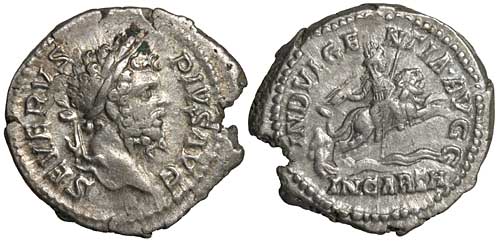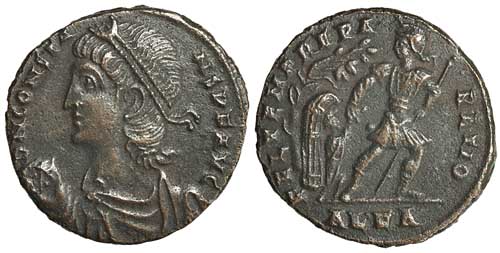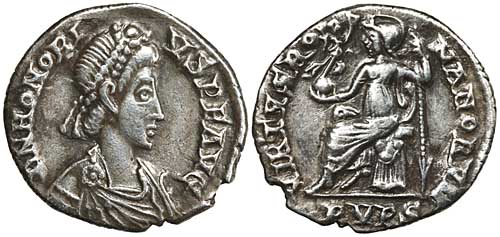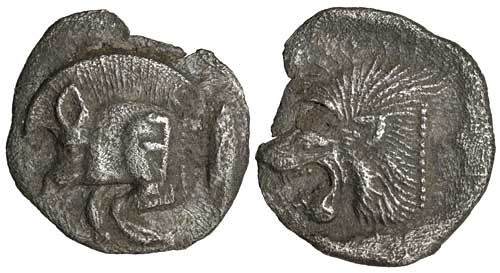| Home Page | Site Map | Useful Links | Email Me | Glossary | Next Page |
| ---------- Interesting Things About Ancient Coins ---------- |
| Coins Of The Month — 2006. |
Many of my coins fit right into this site because I got them particularly to suit a line of thought or a group of coins that I was writing up anyway, or will write up later. But some coins are just nice, or interesting, or peculiar. Maybe I want to say more about an individual coin that's outside the subject of a page. Or maybe I don't have enough related coins to be worth a whole page, which means a page might appear later.
This page is about some of those coins.
I started this page in January 2006, but according to the site stats, it doesn't get many visitors, so I will finish the year and then leave it at 12 coins.
| --------------------------------- January 2006 --------------------------------- |
There is a type of reverse on Imperial Roman coins that shows the emperor doing something important or significant. Examples are: making a speech, sacrificing, setting out on a journey, a triumphal arrival at a city. This is a "setting out" coin.
Setting out was called Profectio, and arrival was called Adventus. It might seem that these should be evenly matched, but in fact it is much more easy to find the arrivals than the departures. These usually show the emperor on horseback, with the legend ADVENTVS AVG. A quick search on Vcoins shows 7 Adventus coins for sale, and no Profectio coins. Perhaps this mismatch is because Adventus coins can show, not only the return from a trip, but also a new emperor's first triumphant arrival in Rome.
Here is a site (belonging to the State University of New York) that shows several of these conventions of Roman Imperial iconography on ornate panels, which provide much more detail and more symbolism than a coin has room for.
Caracalla looks frowning and stern on this coin – his image on coins got more and more scary as he grew older. At the time this coin was minted, he had disposed of his brother Geta, and was reigning as sole emperor. This was the year in which he marched north to battle the Alemanni. Although he was popular with the troops, this expedition wasn't actually a great success.
 |
Coin Type: Silver denarius of Caracalla Mint and Date: Rome, 213 CE. Size and Weight: 18 by 19 mm, 2.9g Obverse: Laureate bust right seen from behind. ANTONINVS PIVS AVG BRIT Reverse: Caracalla, in military attire, standing right holding transverse spear in both hands (point up), two military standards behind. PROFECTIO AVG Ref: RCV (2002) 6876, RIC 225 Provenance: Joe Mastrario, November 2005; ex Wayne Sayles (no date). BW Ref: 016 018 071 |
| Click on the picture for a larger scale view of the coin |
This coin reached me with some difficulty. I bought it from a reliable eBay seller, Joe Mastrario (trading as imperator_coins) in November 2005. Although it was perfectly well packed, when the envelope arrived, it had been torn open and the contents were missing. Three "global priority" envelopes from the USA arrived like this at about the same time, two opened using the tear strip, one carefully cut open. So I thought the coins were gone for good.
Soon afterwards, I had a pleasant surprise – one of the other suppliers (Barry Murphy, a well-known Vcoins seller) told me that he had received both his coin and Joe's! They had been returned together by the UK Post Office. So, Barry sent both coins back to me. That they took 5 weeks to arrive, while other packages were taking one or two weeks, made me think they were lost again .. luckily, they weren't! So this coin has had more than its fair share of "setting out".
| --------------------------------- February 2006 --------------------------------- |
This is an unusual variation of a quite common type known as a Fallen Horseman, a sub-group of "Fel Temp" coins. (There are several other types with the reverse legend "FEL TEMP REPARATIO" – for example, the hut coins on this page.)
Fallen Horseman coins all have several points in common. The horseman, on the left, is under attack from a much larger Roman soldier on the right. The horse is stumbling or has fallen. The horseman is in a submissive posture. The soldier is leaping up and stabbing downwards with his spear. The horseman's shield has been dropped and is somewhere on the right of the coin.
Normally, the horseman is leaning forward over his horse. This variant, where the horseman is off the horse, down on one knee and facing the soldier, is unusual.
 |
Coin Type: Billon centenionalis of Constantius II, 337-361 CE Mint and Date: Rome, officina 4, 350 CE. Size and Weight: 23 mm, 4.6g Obverse: Laurel and rosette diademed, draped, cuirassed bust right, holding globe in right hand. D N CONSTAN - TIVS P F AVG Reverse: Helmeted soldier to left, shield on left arm, spearing fallen horseman; shield on ground at right. Horseman wears pointed cap, kneels to right and raises hands. Star in left field, A below. FEL TEMP RE - PARATIO Exergue: R Q Ref: RIC VIII Rome 174 |
| Click on the picture for a larger scale view of the coin |
The two sides really are differently coloured – it's not a trick of the photo or your browser. This is not rare, and is probably caused by the coin lying on a flat surface during at least part of the time since it was made, exposed to the elements on only one side.
I don't own this coin any more. Soon after I bought it, someone else asked for it. That person is Dane Kurth, who uses the name Helvetica on-line and has an excellent fallen horseman page which I recommend to you as a gallery of different versions. So, what was my coin can now also be seen on Helvetica's "Fel Temps of Rome" page." If you are interested in fallen horsemen, you should also check out Doug Smith's article on them.
| --------------------------------- March 2006 --------------------------------- |
This fake imitates a limes coin. The origin and even the use of limes coins are hotly disputed by various collectors and experts. But they are generally cast in base metal, and appear to be copies of official coins which circulated in silver. This one is not cast, but struck.
It looks strange. The metal colour is rather light for a limes coin. The face is not quite normal, and the Spes on the reverse doesn't look like others of that period (there are some you can compare with on this page). For example, she's walking flat-footed, not on tiptoe, and the drapery of her dress is being pulled out backwards, not upwards.
Curtis Clay, seeing this on a Forvm discussion page, pointed it out as a modern fake made from Bulgarian dies and referred me to a fake denarius which is a die match. To see the report of a similar fake silver denarius on Forvm, look here.
I think it is very odd that someone would fake a base metal coin when they could have made another silver one instead. Perhaps they ran out of silver! But look at the trouble they have gone to. There is a faked patina, which is not bad, if perhaps a little even. Then there is the encrusted sandy material, which must have been glued on. In fact, this coin is worth having on hand as an example of how it can be done.
| --------------------------------- April 2006 --------------------------------- |
How do you ride a lion? Sidesaddle, apparently! The reverse of this coin shows the heavenly goddess Dea Caelestis riding in this awkward way.
Dea Caelestis was the patron goddess of Roman Carthage. This coin clearly celebrates some water-related benificence of the Augusti to that city, perhaps the completion of an aqueduct. The other Augustus at the time was Caracalla, one of Septimius' sons, and similar coins were issued in his name.
 |
Coin Type: Silver denarius of Septimius Severus, 193 CE - 211 CE Mint and Date: Rome, 204 CE. Size and Weight: 19 mm x 21 mm, 3.8g Obverse: Laureate bust right. SEVERVS PIVS AVG Reverse: Dea Caelestis holding thunderbolt in R hand and tall transverse sceptre in left hand, seated facing on lion, head right. Lion is leaping right over a stream of water which gushes from a pile of rock on left. INDVLGENTIA AVGG Exergue: IN CARTH Ref: RCV (2002) 6285 var BW Ref: 039 021 074 |
| Click on the picture for a larger scale view of the coin |
Interestingly, after the death of Julia Domna, Septimius' wife, she was deified, and was worshipped in Carthage as Dea Caelestis.
Some versions of this coin show Dea Caelestis carrying a drum. A drum and lion would suggest Cybele, the Mother Goddess. It's not unusual for deities to have overlapping attributes and associations, and Cybele rides a lion on several coins. This particular depiction of the Mother Goddess riding a leaping lion is said to be based on a statue of Magna Mater on the roof of her shrine on the spina of the Circus Maximus in Rome. There is a Commodus reverse showing it, and the same figure appears on a coin of Julia Domna from Nikopolis.
| --------------------------------- May 2006 --------------------------------- |
This coin type has been the subject of some speculation. A soldier is leading a small figure from a hut under a tree. Does the soldier represent the emperor? Or is this perhaps a personification of Virtus, the manly and soldierly virtues? Is the small figure a barbarian being led into the Roman empire? Of perhaps it represents the gathering of slaves in conquests.
I have a page dedicate to these "hut" coins here.
 |
Coin Type: Bronze centenionalis of Constans, Caesar 333-337 CE, Augustus 337-350 CE Mint and Date: Alexandria, officina 1; 348-350 CE Size and Weight: 19mm x 20mm, 4.1g Obverse: Pearl-diademed, draped, cuirassed bust left, globe in right hand. D N CONSTA - NS P F AVG Reverse: Helmeted soldier, spear in left hand, advancing right, head left; with his right hand he leads a small bare-headed figure from a hut beneath a tree. The spear points downwards, between the soldier's legs. FEL TEMP REPA - RATIO Exergue: ALEA Provenance: Lars-Bertil (eBay), April 2006 Ref: RIC VIII Alexandria 60 BW Ref: 082 021 000 |
| Click on the picture for a larger scale view of the coin |
This particular coin shows an unusually huge difference between the soldier and the smaller figure. Look at the soldier's huge, ropey arm and mammoth hand grasping the weedy, stick-like forearm of the barbarian! That arm is even out of proportion to the rest of the soldier. On most of these coins the soldier is grasping the small figure's hand, but on this one he's pulling him by the forearm. There was to be no doubt as to who was the natural superior in this relationship!
| --------------------------------- June 2006 --------------------------------- |
This is a silver siliqua of Honorius. It was struck in Ravenna, in north-eastern Italy, and is quite scarce. It shows Roma seated on an elaborate bench, wearing the helmet she had been shown in since the days of the Republic. She is holding a reversed spear, point down to show it's not actually being used at the moment. Her relaxed attitude is shown by her crossed legs. In her right hand is a globe, and on the globe is a figurine of Victory, which is holding out a wreath to crown Roma. You might rightly think that this is rather self-congratulatory. In fact, Honorius transferred his court to Ravenna in 404, and in 410, he allowed the Goths under Alaric to sack Rome.
 |
Coin Type: Silver siliqua of Honorius, 395-423 CE Mint and Date: Ravenna; ? Size and Weight: 17mm, 1.8g Obverse: Diademed draped bust right. D N HONORI - VS P F AVG Reverse: Roma seated left, spear point down in left hand, right hand holding globe with Victory holding wreath. VIRTVS RO - MANORVM Exergue:RVPS Ref: RCV (1988) 4250; RIC X, 1297 Provenance: antikacoins (eBay), August 2005 BW Ref: 003 012 028 |
| Click on the picture for a larger scale view of the coin |
This coin is slightly smoothed, showing that it has been in circulation - just enough to give it an aura of history without losing any details. The very stylised bust lends it an air of individuality. It's a nice coin!
| --------------------------------- July 2006 --------------------------------- |
Vabalathus ruled Palmyra, a powerful eastern kingdom which derived its wealth from its position as a trading post. Palmyra became separated from Rome at a time when the empire was weak, and under Vabalathus' parents it made some local conquests. Vabalathus made gestures towards Rome like this coin, which showed Aurelian as emperor and Vabalathus as holding lesser titles. But Aurelian was a strong emperor, and would not concede independence to Palmyra; and so Vabalathus seceded, only to be beaten by Aurelian and taken back to Rome as a captive, together with his mother Zenobia.
 |
Coin Type: Potin tetradrachm of Vabalathus, 270-271 CE Mint and Date: Alexandria, 270 CE Size and Weight: 18mm x 20mm, 9.6g Obverse: Laureate, draped and cuirassed bust right, L A (Year 1) in left and right field. AVT K AVPHΛIANOC CEB Reverse: Laureate and diademed, draped and cuirassed bust R, L Δ (Year 4) in left and right field. IAC OVABAΛΛAΘOC AΘHNO V AVT CPw Ref: RCV (1988) 3293; DRC Vabalathus (II) 8 Provenance: Gault Coins (Vcoins), June 2006 BW Ref: 002 023 079 Note: The Vabalathus side is often considered to be the obverse. |
| Click on the picture for a larger scale view of the coin |
Vabalathus struck coins at the eastern mints of Antioch and Alexandria. The coins from Antioch all show very stylised portraits, but some of the Alexandrian tetradrachms look quite individualised. This is the best portrait of Vabalathus I have seen.
| --------------------------------- August 2006 --------------------------------- |
This one is included because it is so different from the Roman and Greek types I usually collect, with very interesting similarities and differences.
It's square instead of round, yet still follows the pattern of a central image with a legend running round it. It's bilingual, an indication that it was meant to be understood, not just stand as currency. Herakles is in a traditional Greek pose, yet is styled very diferently. It's nice to look at!
| --------------------------------- September 2006 --------------------------------- |
This coin of King Agathocles is included just because it's strikingly beautiful.
 |
Coin Type: Bronze litra of Agathocles of Syracuse, 317-289 BCE Mint and Date: Syracuse, 317-289 BCE Size and Weight: 22mm, 8.2g Obverse: Bust of Artemis right, quiver over shoulder. ΣΩTEIPA Reverse: Winged thunderbolt. AΓAΘOKΛEOΣ above, BAΣIΛEOΣ below. Ref: GCV 1200; BMC 2, 422; Calciati II pg. 277, 142. Provenance: mediterraneancoins (Vauctions), May 2005 BW Ref: 003 026 030 |
| Click on the picture for a larger scale view of the coin |
Artemis the huntress, labelled "Saviour," is pictured with her quiver over her shoulder, and her hair in a
practical yet flattering swept-back style. Compare this with a Roman Republican depiction of
her Roman equivalent, Diana, here. There is no change over 200 years –
quite a good demonstration of the Roman reverence for their own classical history!
On the other side is an elaborate winged thunderbolt. This is not at all how thunderbolts are portrayed
in modern times. Now, they tend to be jagged lines, or clusters of them, but the represention shown here
was quite normal 2,000 years ago.
| --------------------------------- October 2006 --------------------------------- |
This coin is dedicated to Segetia, a goddess who is not often seen on coins. Her name comes from the Latin for a grain field or crop, and she was a goddess of the harvest. According to the Dictionary of Roman Coins, "We are informed by Millin (in his Dictionnaire de la Fable) that this female deity was invoked for the fields at seed time, under the name of Seia, and that she was not called Segetia until the plant had grown up."
 |
Coin Type: Billon antoninianus of Salonina, 253-168 CE Mint and Date: Cologne, 259-260 CE Size and Weight: 21mm x 22mm, 3.1g Obverse: Diademed, draped bust right, resting on crescent. SALONINA AVG Reverse: Dea Segetia, veiled, crescent on head, standing facing in tetrastyle temple, both hands raised, open, palm upwards. DEAE SE - GETIAE Ref: RCV (2005) 10631; RIC V vol I 5. BW Ref: 010 027 087 Note: Evidence of a die clash on the reverse. |
| Click on the picture for a larger scale view of the coin |
The coin is evidence that Salonina caused a temple to Segetia to be constructed. The Dictionary says this was associated with Salonina providing for Rome during a time of "great public calamity." Segetia would then have been invoked to provide her protection for the crops of corn and other grain at the time of harvest.
Before then, Segetia's only monument in Rome had been a shrine at the Circus Maximus.
| --------------------------------- November 2006 --------------------------------- |
This is such a stunning little coin that I can't leave it out. It's extremely small and light, yet has these two strong and vivid designs on each side - the forepart of a charging boar with a crest of bristles, and the head of a lion with flowing mane and gaping jaws.
The obverse of this coin is also on my "Crystallised Coins" page.
 |
Coin Type: Silver obol of Kyzikos in Mysia, 480-450 BCE Mint and Date: Kyzikos, 480-450 BCE Size and Weight: 11mm, 0.8g Obverse: Forepart of boar left, retrograde E on body. Upright tuna behind. Reverse: Lion head left, in incuse square. Ref: GCV 3848 Provenance: Barry Murphy, Vcoins, March 2004 BW Ref: 002 005 022 |
| Click on the picture for a larger scale view of the coin |
It's said that people carried little silver coins like this inside their cheeks. There is an indirect reference to the practice in Aristophanes' saritical play "The Birds", written in 414 BCE. Silver has a bactericidal effect, but even so, given the amount of dirt that accumulate on coins, one can only presume that they had effective immune systems!
| --------------------------------- December 2006 --------------------------------- |
Here is a coin of Marcus Aurelius with an unusual reverse type - Juventas, the goddess of Youth.
 |
Coin Type: Silver denarius of Marcus Aurelius, Caesar 139-161 CE, Augustus 161-180 CE Mint and Date: Rome, 143 CE. Size and Weight: 17mm x 18mm, 3.3g Obverse: Bare-headed draped bust right. AVRELIVS CAESAR AVG PII F COS Reverse: Iuventas standing facing, head left, right hand dropping incense onto candelabrum-altar below, left hand holding patera downwards at waist level. IVVENTAS Provenance: Ancient Imports (Vcoins), November 2006 Ref: RIC III 423a BW Ref: 011 029 095 |
| Click on the picture for a larger scale view of the coin |
There was a temple of Juventas at Rome, where money was deposited by those who first wore their manly toga, the toga virilis. This was said to be a very ancient custom. This coin shows the youthful Marcus Aurelius, and may refer to the occasion when he was first shaved, and the collected results were consecrated to the same goddess Juventas.
| --------------------------------- Key To Some References --------------------------------- |
RCV = Sear's "Roman Coins And Their Values", the year indicating which volume is referenced. 1988 is the one-volume version. 2000, 2002 and 2005 are volumes 1-3 of the "millennium edition" of which three volumes have appeared as of December 2007.
GCV = Sear's "Greek Coins and their Values", a two-volume compendium of the ancient coins of Greece and its colonies that gives all the common and well-known types and a fair few of the more obscure ones as well.
RIC = The Roman Imperial Coinage, a 10-volume attempt to give a complete list of all Roman coins and their varieties. I have several volumes, which vary in usefulness.
| The content of this page was last updated on 28 August 2008 |
| Home Page | Site Map | Useful Links | Email Me | Glossary | Next Page |

